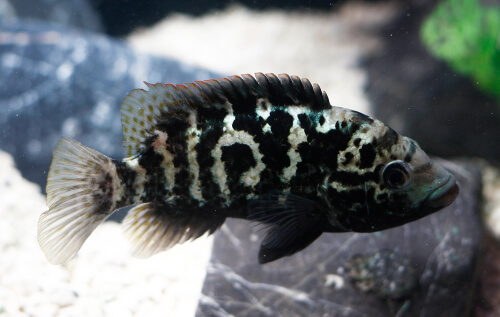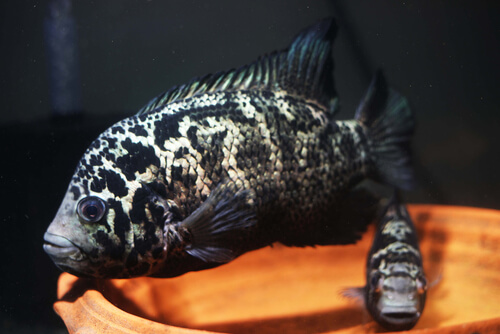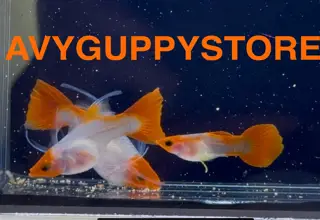Cuban Cichlid: Care, Size, Appearance, Tank Mates & More
Posted by on 02/17/2023
We use affiliate links and may receive a small commission on purchases.
Large, powerful, and aggressive, the Cuban Cichlid is a territorial fish that only the experienced aquarist should consider. These fish have unique care requirements, and hobbyists looking to get their hands on one should be well aware of the challenges they present.
While the species was recognized over one hundred years ago, it’s only recently increased in popularity. Fish-keeping knowledge has spread rapidly due to the internet, opening up many opportunities for aquarists looking to house large Cichlid species. In this post, we’ll cover everything regarding the Cuban Cichlid. We’ll discuss their overall care, diet, breeding, and much more.
December's Giveaways on Light Fish
Species Summary
The Cuban Cichlid (scientific name: Nandopsis tetracanthus) was first scientifically classified by French zoologist Achille Valenciennes . The species can be found throughout Central America and the island of Cuba, where it lives in fast-moving freshwater and brackish rivers.
While there is a healthy population of the species, it’s most commonly seen near the western part of the island of Cuba, near the city of Havana, where it’s been given a Least Concern status by the IUCN . Luckily for hobbyists, the species is easily bred in captivity.
3 different species fall under the Nandopsis genus. Nandopsis haitiensis, Nandopsosis rasendi, and the Cuban Cichlid: Nandopsis tetracanthus.

Appearance
The Cuban Cichlid has an appearance similar to a Green Texas or Electric Blue Jack Dempsey. The body of the fish is iridescent silver, which is broken up by a series of black spots that make up curvy patterns that appear on the body of the fish.
The dorsal, caudal, pectoral, and anal fins all showcase the color pattern except for the pectoral fins which are a translucent gray. Large lips, black eyes, and a small nuchal hump make up the front of the fish.
🛒 Shop Freshwater Fish on Light Fish
Male vs Female
Hobbyists looking to distinguish between male and female Cuban cichlids should look towards the Dorsal fin, which will appear much darker in females compared to males.
However, it can be difficult to accurately determine the gender, if a male is not present in the tank, females may change colors and take on male coloration, turning a lighter color.

Size
An adult Cuban Cichlid is a large fish and will grow to reach about 10 inches in length.
When sold as juveniles, these fish will be significantly smaller, about 5 inches depending on the age of the fish. Providing a nutrient-rich diet, combined with stable water parameters and a stress-free environment will allow your fish to reach its full adult size.
Cuban Cichlid Care
Cuban Cichlids have unique care requirements. Due to their large size, they’ll need a massive aquarium and consistent feeding. If you’re looking to take on the challenge of owning one of these fish, you’ll want to re-create their natural habitat as best as possible.
These fish are primarily from the Cuban mainland, where mangroves and rainforests thrive in Cuba’s tropical environment. Warm water rivers play host to these species, presenting an exciting challenge for hobbyists looking to recreate such a unique habitat.
Lifespan
When given proper care, Cuban Cichlids can live between 9-12 years in captivity.
If possible, you’ll want to inquire about the age of the fish before purchasing. This way, you can better predict their life expectancy. Cuban Cichlids are long-lived fish, and you’ll want to prepare for a decade’s worth of care. Since this fish is so large and territorial, it will be difficult to rehome if you can no longer care for the species.
Tank Size
You’ll need an aquarium that’s at least 100 gallons in size if you plan on owning a Cuban Cichlid
Their large size and aggressive nature make a 100-gallon tank an absolute must. If the budget allows, the bigger the better.
Water Conditions
Cuban Cichlids come from an environment with moderately hard water, where it swims in areas of dense vegetation.
Aim for the following parameters:
Temperature Range: 75°F-86°F
pH: 7.0-8.0
Nitrite: 0 ppm
Ammonia: 0 ppm
Nitrate: < 40 ppm
Although these fish have a reputation for being quite hardy, sustaining these conditions will give your fish the best chance at living a long and healthy life.
Tank Setup
Once you’ve set up an aquarium large enough for a Cuban Cichlid, you’ll want to plan for a suitable aquascape. It’s important to leave plenty of open space so that the Cuban Cichlid can swim throughout the tank, and it's always wise to consider adding live plants.
Not only do live plants look aesthetically pleasing, but they can also help purify the water by consuming the harmful toxins released from fish waste.
Since cichlids tend to be a bit more aggressive and have a tendency to knock things over, you’ll be limited in the plants you can choose.
Some durable plants that work well with a Cuban Cichlid include:
Java Fern
Anubias Nana
Anubias Nana Petite
These plants can be tied down to rock work, such as Seiryu stones and Driftwood using a fishing line. After a few weeks have passed, the roots of these plants will wrap themselves around whatever they're attached to.
In terms of substrate, both sand and gravel work well. Many hobbyists prefer dark-colored gravel substrates, such as eco-complete , but substrate coloration mostly comes down to personal preference.
Cuban Cichlids will also appreciate moderate levels of flow, which can be achieved using an adjustable powerhead .
Common Diseases
Cuban Cichlids are susceptible to many of the same diseases that affect most freshwater species. One of the most common is known as Hole in the Head Disease and is brought on by stress and/or poor water quality. If infected, small eroding holes will appear over the head of the fish, and will eventually make their way over the body.
Treatment for Hole in the Head typically involves metronidazole . The medication is sold in a pill form, which will rapidly dissolve in an aquarium. You’ll need to treat the fish in an established, well-filtered, hospital tank over 10 days until symptoms improve.
Another common disease to affect Cuban Cichlids is known as Ich. Oftentimes, this disease presents itself when infected fish are first introduced into an aquarium. Ich symptoms involve the appearance of small white dots that cover the body of the affected fish. The fish may be seen rubbing itself against the substrate or hardscape, a maneuver known as “flashing”.
If left untreated, the disease is fatal, so you’ll want to take action right away. Luckily, the parasite is treatable by increasing the water temperature in the aquarium for 10 days. You’ll want to raise the temperature to between 80-82°F.
If raising the temperature doesn’t cure the affected fish, you can pursue alternative forms of treatment, such as Hikari's Ich X . If you choose to use medication, we always recommend performing the treatment in an established hospital tank, rather than the display tank.
Food & Diet
Cuban Cichlids should be fed nutrient-rich pellet food and flake food, at least 1-2 times per day.
Feed enough food that the fish will consume in a 2-3 minute period. Cuban Cichlids are big eaters, and you can supplement their diet with Baby Brine Shrimp and Blackworms. Bloodworms can also be fed as an occasional treat.
Avoid overfeeding your Cuban Cichlids, as these fish are susceptible to bloat.
Behavior and Temperament
Cuban Cichlids are aggressive fish, even as juveniles. While personalities will vary between each specimen, it’s best to assume that all Cuban Cichlids will display aggressive personalities.
Peaceful, smaller fish will be chased and bullied around an aquarium, as the Cuban Cichlid is highly territorial, even bullying its own species.
However, when they’re not trying to compete for territory, they are relatively laid back. Cuban Cichlids are often found floating in place along the middle of the water column and swimming toward their owners come feeding time.
Tank Mates
Due to their aggressive personalities, Cuban Cichlids are best kept in a species-only aquarium.
Some hobbyists have reported success in keeping these fish with Plecos, other aggressive fish such as the Electric Blue Jack Dempsey, and even smaller fish, such as Blue Emperor Tetras, but nothing is a guarantee when keeping such an aggressive fish. Smaller invertebrates such as Black Mystery Snails and Orange Pumpkin Shrimp should be avoided.
The only risk-free tank mate is a female Cuban Cichlid.
Breeding
If you’re interested in breeding Cuban Cichlids, you’ll be pleased to know that these fish readily breed in captivity. The challenge comes with finding a mating pair.
Since it’s difficult to determine the gender of these fish, many breeders will raise a small group of them (typically around 6), and observe them for a potential pair-up.
If a pairing occurs, you can remove the excess fish or place the pair into a breeding tank, which should be an established, well-filtered aquarium containing a small cave, and a flat surface or breeding cone . Water parameters should match your display tank, except for temperature which can be increased by 2-3°F.

Cuban Cichlids will spawn monthly, and If successful the female will lay hundreds of eggs at a time. After about 3 days of being defended by their parents, the eggs will hatch into fry. You’ll need to feed the fry small bits of baby brine shrimp, twice a day and perform 50% water changes once a week until they reach a juvenile size, about 4 inches in length.
Once they've reached this stage, you'll have successfully bred the Cuban Cichlid! Now you can consider selling them on our marketplace or to a local fish store.
In Conclusion
As you can see, the Cuban Cichlid is an aggressive species with strict care and tank mate requirements. While you’ll need a massive aquarium to house this fish, owning one is a rewarding experience.
Do you have experience with the Cuban Cichlid? Let us know by commenting below, and be sure to check out our community forum and marketplace where you can meet and discuss fishkeeping with other hobbyists.
December's Giveaways on Light Fish






